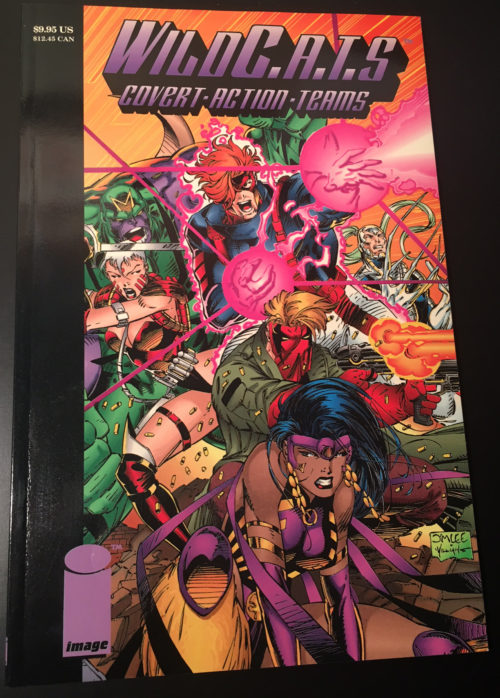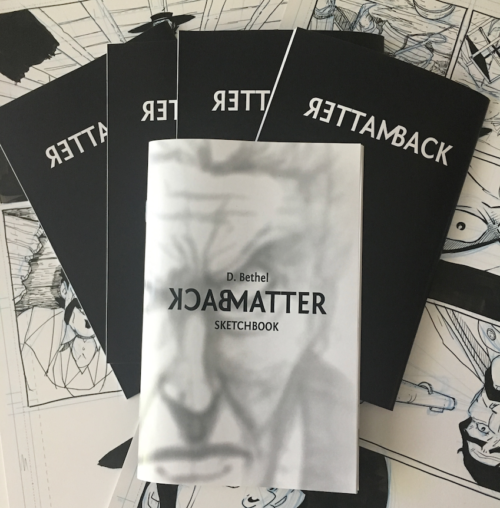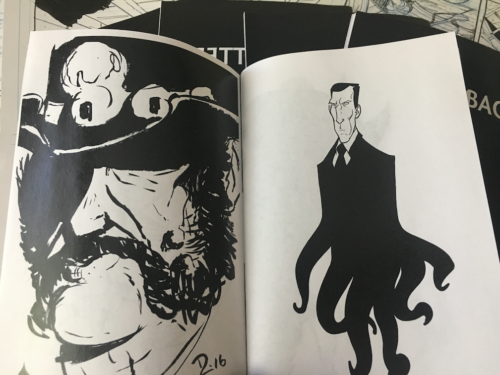BackMatter: The D. Bethel Sketchbook Now Available
My first trade paperback collection of a comic series (commonly called a “trade”) was probably the collection of the four-issue miniseries of Jim Lee’s WildC.A.T.S for Image Comics. The redundancies were immediately recognized––I already had all four individual issues, but with a collection I didn’t have to risk damaging the inherent value of those issues (spoiler alert: those individual issues are still worth cover price twenty years later) by reading this trade instead.

Most likely my first trade, the 1993 collection of Jim Lee’s WildC.A.T.s mini-series.
The best part was the surprise waiting for me at the end of the collection: a few pages worth of development sketches and notes from Jim Lee himself, letting the reader in on how he pulled these characters and story out from a hazy idea into reality and it blew my mind. At that point, for me at least, the comic book industry kept the sausage works carefully hidden behind the curtain, preferring to only show us the shiny, finished product. But here was a rock star of the industry actually showing us messy drawings, half-baked concepts that eventually congealed into full characters that I fell in love with.
I thought such revelations were a one-off, but as I bought more trades––they were fairly rare at that point in the early 1990s––I noticed that most of them had this extra material in the back, to the point now where it’s a standard practice. It’s so standardized, in fact, that this content actually has a name: the back matter. Much like, after a certain point, special features were expected on DVDs and filmmakers would actually plan making that content before/during/after shooting, back matter in trades is something that the creators actively plan for, whether the section brings together all the variant covers for the issues in the collection or it has annotated scripts or other developmental information.
A more recent trend among artists is the release of yearly sketchbooks, collecting drawings––both finished and not––that captures their process for the year. Even though I’ve been making comics for ten years as of 2017, I still don’t think of myself as an artist, for a variety of reasons––mostly due to self-doubt. But since all of these Sketch Fridays and other drawings are posted once online and disappear into the archives, I realized that most of them were good enough to give them another push into the eyes of readers (or potential readers), so that’s where BackMatter: A D. Bethel Sketchbook comes into play.

The BackMatter Sketchbook Collection

A look inside BackMatter.
Long John doesn’t have a trade quite yet––with hope, it one day will––but this would be the kind of stuff I would put into the back matter of a trade. Ideally, I would like to do a Sketch Friday book that has the drawings as well as, at least, some of the accompanying blog posts, but that increases page count and drives up the price.
It was fun to put this book together and, to let you in behind the curtain, it’s loosely organized into three sections (as indicated by the folders into which I organized the files): Personal––meaning non-comic drawings, Long John development drawings, or random doodles, Nerd––meaning fanart of specific comic book or video game characters, and Fan Art––an iteration on the former, but whereas the Nerd section is just drawings of characters, Fan Art is me playing with those characters as well as art inspired by comics, video games, etc. Like I said, it’s a loose organization, but it made sense at the time and is not needed to enjoy the book.
Of course, if you order a copy, I’ll throw in a one-of-a-kind Long John drawing in there for free as well as a Long John bookmark.
With all of that said, again BackMatter is now available for sale on my Etsy store for $5 (plus shipping). It’s a nice little package that you can show your friends or have on the coffee table. Thank you for your support!


Discussion ¬